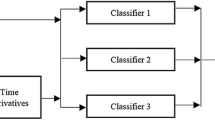Abstract
The paper presents methods of classification based on a sequence of feature vectors extracted from signal generated by the object. The feature vectors are assumed to be probabilistic independent. Each feature vector is separately classified by a multilayer perceptron giving a set of local classification decisions. This set of statistical independent decisions is a base for a global classification rule. The rule is derived from statistical decision theory. According to it, an object belongs to a class for which product of corresponding neural network outputs is the largest. The neural outputs are modified in a way to prevent them vanishing to zero. The performance of the proposed rule was tested in an automatic, text independent, speaker identification task. Achieved results are presented.
An erratum to this chapter can be found at http://dx.doi.org/10.1007/11550907_163 .
Preview
Unable to display preview. Download preview PDF.
Similar content being viewed by others
References
Al-Ani, A., Deriche, M.: A new technique for combining multiple classifiers using the Dempster-Shafer theory of evidence. Journal of Artificial Intelligence Research 17, 333–361 (2002)
Bauer, R., Kohavi, R.: An Empirical Comparison of Voting Classification Algorithms: Bagging, Boosting, and Variants. Machine Learning 36, 105–139 (1999)
Bilmes, J., Kirchhoff, K.: Generalized rules for combination and joint training of classifiers. Pattern Analysis and Applications 6, 201–211 (2003)
Bishop, C.M.: Neural Networks for Pattern Recognition. Clarendon Press, Oxford (1995)
Brock, W.A., Dechert, W.D., Scheinkman, J.A., Le Baron, B.: A test for independence based on the correlation dimension. Econometric Reviews 15, 197–235 (1996)
Diks, C., Manzan, S.: Tests for Serial Independence and Linearity Based on Correlation Integrals. Studies in Nonlinear Dynamics & Econometrics, Article 2, 6(2) (2002)
Hashem, S.: Optimal linear combinations of neural networks. Neural Networks 10, 599–614 (1997)
Kittler, J., Hataf, M., Duin, R.P.W., Matas, J.: On combining classifiers. IEEE Transactions on Pattern Analysis and Machine Intelligence 20, 226–239 (1998)
Kirchhoff, K., Bilmes, J.: Dynamic classifier combination in hybrid speech recognition systems using utterance-level confidence values. In: Proceedings international conference on acoustic, speech and signal processing, pp. 693–696 (1999)
Kuncheva, L.I.: Combining Pattern Classifiers: Methods and Algorithms. John Wiley, New York (2004)
Ripley, B.D.: Pattern Recognition and Neural Networks. University Press, Cambridge (1996)
Ruck, D.W., Rogers, S.K., Kabrisky, M., Oxley, M.E., Suter, B.W.: The multilayer perceptron as an approximation to a Bayes optimal discriminant function. IEEE Transactions on Neural Networks 1, 296–298 (1990)
Walkowiak, T.: Probabilistic Neural Network for Open Set Classification. In: IV National Conference Neural Networks and their Application, Poland, Zakopane, pp. 232–237 (1999)
Walkowiak, T.: A t-Student based Neural Network for Speaker Recognition. In: Proceedings of the Fourth International Workshop Neural Networks in Applications, Germany, Magdeburg, pp. 133–139 (1999)
Walkowiak, T., Zamojski, W.: Heuristic sequential classifiers based on multilayer percepetron and probabilistic neural network. In: 2nd International Conference on Information Technology, Jordan, Amman, pp. 202–206 (2005)
Xu, L., Krzyzak, A., Suen, C.: Methods of combining multiple classifiers and their applications to handwriting recognition. IEEE Transactions on Systems, Man and Cybernetics 22, 418–435 (1992)
Author information
Authors and Affiliations
Editor information
Editors and Affiliations
Rights and permissions
Copyright information
© 2005 Springer-Verlag Berlin Heidelberg
About this paper
Cite this paper
Walkowiak, T. (2005). Sequential Classification of Probabilistic Independent Feature Vectors Based on Multilayer Perceptron. In: Duch, W., Kacprzyk, J., Oja, E., Zadrożny, S. (eds) Artificial Neural Networks: Formal Models and Their Applications – ICANN 2005. ICANN 2005. Lecture Notes in Computer Science, vol 3697. Springer, Berlin, Heidelberg. https://doi.org/10.1007/11550907_53
Download citation
DOI: https://doi.org/10.1007/11550907_53
Publisher Name: Springer, Berlin, Heidelberg
Print ISBN: 978-3-540-28755-1
Online ISBN: 978-3-540-28756-8
eBook Packages: Computer ScienceComputer Science (R0)




